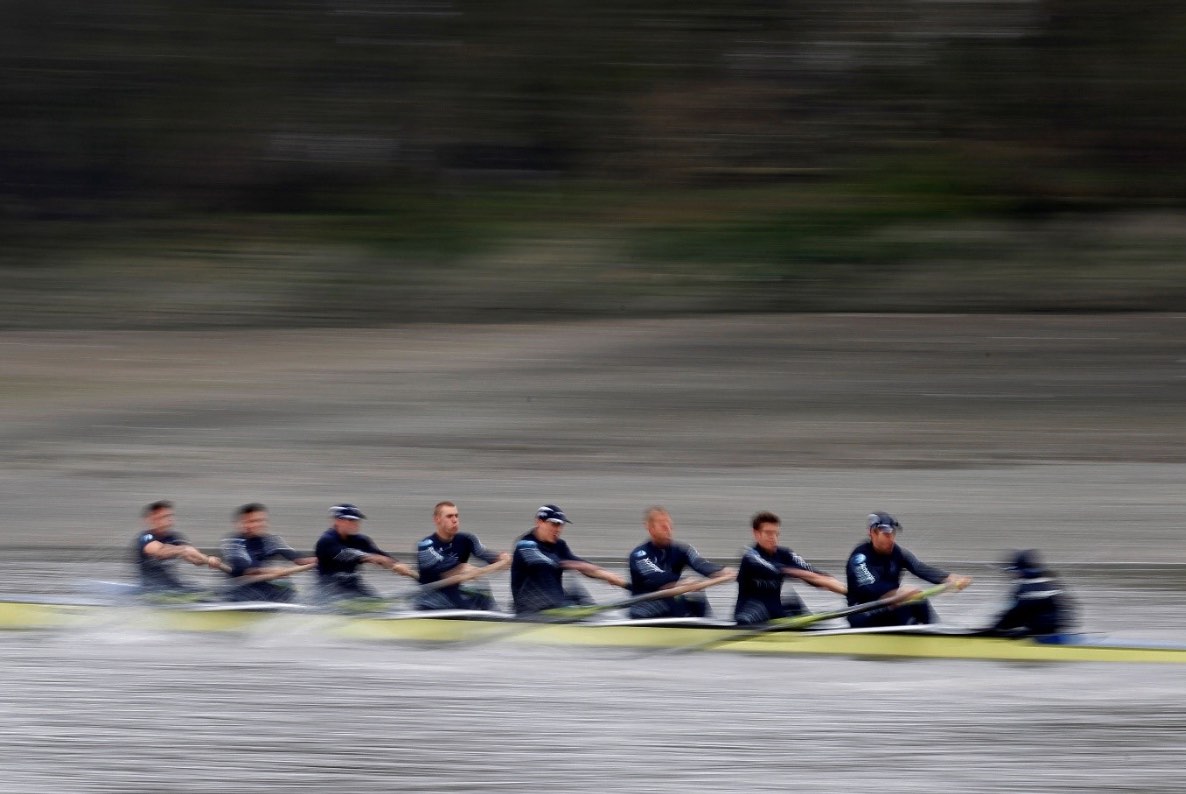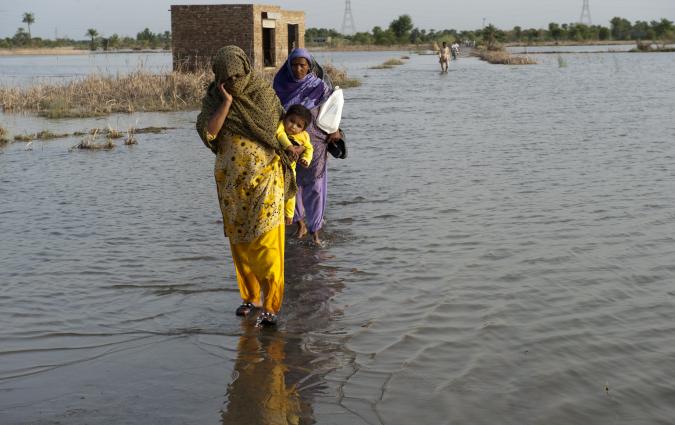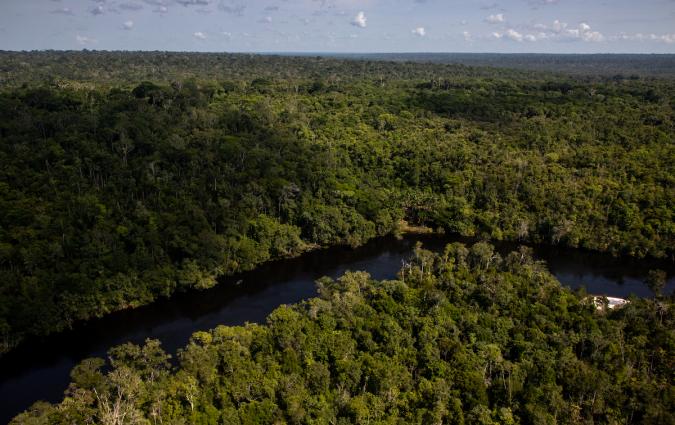In this piece
Rowing together for better climate coverage

The Oxford University rowing crew practice on the River Thames. REUTERS/Stefan Wermuth
In this piece
The structure | The knowledge | The audience | The leadership | Reimagine how we pitch and present climate stories | Additional leversJoin me for a moment as part of an Oxford University rowing crew. We are part of a team, rowing down the Thames, past boathouses. The team is in great shape, and we are gliding at pace.
Suddenly you notice we are on the wrong track: we must stop the boat and turn back as soon as possible. You try desperately to warn the crew, but no one is listening. The boat keeps going, and it is getting faster. Despite your warnings, we are heading straight for a catastrophe.
That anxiety is close to what climate scientists have been feeling. For decades they have told us we are heading towards a climate catastrophe and must act now. In the light of the IPCC’s findings that we need to cut emissions radically, as well as the warnings of the World Economic Forum that failure to act on climate change is the most significant risk over the next decade, there is no doubt that the climate crisis is reshaping our understanding of all parts in our life – be it our work, our lifestyle, finance, mobility or health.
But the news media still seem to be struggling to find its place. When I conducted an online questionnaire in my own newsroom at Zeit im Bild (ZIB), 40% of respondents felt uncertain about what audiences needed to know about climate change and 27% said they did not feel supported to cover climate change news.
ZIB has been running since 1955 as the Austrian public broadcaster’s main news bulletin on ORF 1 and ORF 2 in the morning, afternoon, and evening. It is the most-watched news programme in Austria.
My respondents account for only 27% of the total journalists working on ZIB (15 of 56), meaning these results should not be considered representative. They do, however, point to some problems. And we are not unique in this regard.
I spoke to journalist and researcher Alexandra Borchardt who recently authored an EBU climate journalism report about how European public broadcasters are covering climate change. She interviewed journalists and media managers in Europe’s biggest newsrooms and told me that she was shocked to find that, with a few exceptions, most newsrooms had no strategy for covering climate change.
Climate coverage requires a reorganisation of newsrooms. But where should we start? There is no one-size-fits-all solution. But there are lessons we can share, and tools everybody can use.
That’s why I spent my fellowship at the Reuters Institute for the Study of Journalism investigating the nature of the challenges surrounding climate change journalism. Full findings are attached in the PDF below, but they can be summarised in five categories.
The structure
Many media houses answer the challenge of climate change coverage by setting up a desk. According to the Oxford Climate Journalism Network’s Wolfgang Blau, newsrooms typically choose one of the following three structures when they want to expand their climate reporting:
-
They decide to expand their existing science desk by increasing budget or staff. (Pro: prevents internal conflicts. Con: newsroom learning is siloed and slow.)
-
Some newsrooms set up a new climate desk. (Pro: development of a new team, expansion of expert staff, and greater PR value. Con: internal frictions with the current science desk.)
-
Others form an interdisciplinary “climate hub” with existing personnel. (Pro: progress made towards including climate-related elements in all stories. Con: There is no replacement for having scientific journalists and climate specialists.)
A fourth, less structural option, is to release new formats: such as podcasts or supplements dealing with climate change. (Pro: A good way to start the conversation about climate. An opportunity for hidden potential or talent in the newsroom to shine. Con: they cost time and, in many cases, do not deliver the expected output or reach the desired audience.)
Choosing any one of these strategies is commendable, according to Blau, but in many cases the newly installed climate desks don’t have the desired effect on the rest of the newsroom. Expertise and coverage are kept siloed on a story that will affect every part of our lives. Instead, he suggests fostering a culture where “every story is a climate story”.
A fifth suggestion comes from Sara Schurmann, who would like to see a temporary managing climate editor installed as part of the chief editor’s team. The managing climate editor should take part in all relevant editorial meetings and make others aware of climate aspects in their story. This strategy ensures that there are no more stories online, printed or published that simply do not mention climate change aspects when they are necessary and appropriate.
The knowledge
Experts agree: All journalists in the newsroom need basic climate literacy. In a CNN interview, Emily Atkin, a US-based climate change reporter, draws parallels with the COVID-19 pandemic, a global crisis that affected every area of our lives. Our coverage of the pandemic was not outsourced to the science desk; the whole newsroom mobilised to cover that crisis.
“There is no excuse today for reporters who do not understand the basic scientific facts of COVID-19. Why is that different when it comes to climate change? Right now, everyone should be a climate reporter. And if you're not a climate reporter right now, you will be one soon, whether you realise it or not.”
The audience
A report titled Global Warming’s six Americas from researchers at Yale University and George Mason University found the audience can be divided into six categories: alarmed, concerned, cautious, disengaged, doubtful, and dismissive.
To grasp information in climate crisis reports, the audience needs at least a basic knowledge of climate change. As in the COVID-19 crisis, journalists should select climate-specific key figures and terms to explain, repeat and update frequently. For example, news outlets might publish the daily CO2 amount in PPM, explain the energy mix of a country in percentages, or host an interactive dashboard on their website. Some outlets already do this: see Bloomberg Green for example.
The leadership
Every new structure or strategy depends on the engagement and commitment of a newsroom’s leadership team. If the editor-in-chief and their team do not see climate change as a systemic issue across all desks, climate editors and reporters will find it difficult to have a significant impact. The European Broadcasting Union (EBU) emphasises this in their recent report. One of their preliminary key findings is that change will be impossible without engagement of editors.
Reimagine how we pitch and present climate stories
If climate change news is consistently bad and hopeless, editors and audiences tend to turn away and begin ignoring it. So how should we tell climate stories? In our interview, Hans Cosson-Eide from Norway’s public broadcaster NRK told me the stories that work best are news stories that people don’t necessarily see as climate stories. Simon Mundy from the Financial Times echoed this: “When pitching a story, it is not mandatory to claim it as a climate story; the key question is why somebody should care.”
Additional levers
There are five additional levers – all existing tools – to consider when formulating the right environment for good climate coverage:
-
Newsrooms need a plan for dealing with online trolling and coordinated discrediting of journalists. See the roadmap for digital security.
-
Newsrooms need a strategy around visuals used to illustrate climate change stories. A helpful resource is Climate Visuals.
-
Journalists will need good access to scientists and sources. See Global South Climate Database.
-
Attribution science is critical but not easy. Not all extreme weather events are caused by climate change. See the World Weather Attribution project.
-
Sometimes climate stories are not given top billing because editors are afraid they do not perform well. This is a result of relying too heavily on performance metrics instead of impact metrics. These are harder to measure but more instructive to long-term strategy. The mere existence of climate stories, pushed out during off-peak times to tick a box, should not be considered a climate strategy. See Gamperl’s Metrics Anxiety.
Now it is time to right the course of our boats, so to speak. Whether we are rowing or covering climate change, to be successful we will need training, clear structures, a motivated team, and good leaders.
Yes, climate change is a big challenge, but we are all in the same boat. So, grab your paddle, your pencil or microphone, and let’s turn this boat around.
In every email we send you'll find original reporting, evidence-based insights, online seminars and readings curated from 100s of sources - all in 5 minutes.
- Twice a week
- More than 20,000 people receive it
- Unsubscribe any time



